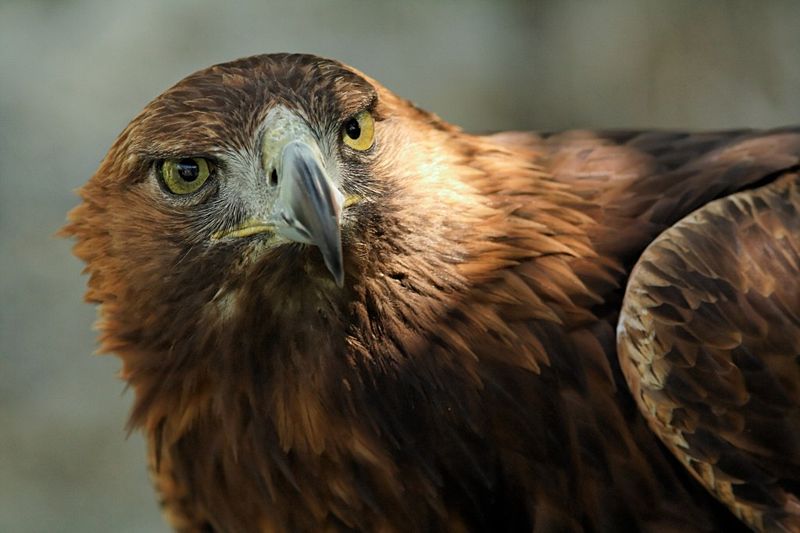
The Golden Eagle (Aquila chrysaetos) is one of the best known birds of prey in the Northern Hemisphere. Like all eagles, it belongs to the family Accipitridae. Once widespread across the Holarctic, it has disappeared from many of the more heavily populated areas. Despite being locally extinct or uncommon, the species is still fairly ubiquitous, being present in Eurasia, North America and parts of Africa. These birds are dark brown, with lighter golden-brown plumage on their heads and necks. It has a wingspan averaging over 2 m (7 ft) and up to 1 m (3 ft) in body length. They are extremely swift, and can dive upon their quarry at speeds of more than 150 miles (241 kilometers) per hour[citation needed]. Golden eagles use their speed and sharp talons to snatch up rabbits, marmots, and ground squirrels. They also eat carrion, reptiles, birds, fish, and smaller fare such as large insects. They have even been known to attack full-grown deer. Golden eagle pairs maintain territories that may be as large as 60 square miles (155 square kilometers). They are monogamous and may remain with their mate for several years or possibly for life. Golden eagles nest in high places including cliffs, trees, or human structures such as telephone poles. They build huge nests to which they may return for several breeding years. Females lay from one to four eggs, and both parents incubate them for 40 to 45 days. Typically, one or two young survive to fledge in about three months. Adult Golden Eagles range considerably in size, though some are among the largest eagles of the genus Aquila. Most subspecies of Golden Eagle vary in the range from 65 to 100 cm (26–40 in) in length, wingspan can range from 150 to 240 cm (60–96 in), and weight is from 2.5 to 7 kg (5.5–15.5 lb). The smallest-bodied subspecies is A. c. japonica while A. c. daphanea is the largest on average.[1] However, wild specimens from Northwestern North America (A. c. canadensis) can exceed normal dimensions, as the largest recorded weighed 9 kg (20 lbs) and had a body length of 102 cm (40.1 in).[2] As with many Accipitriformes, females are considerably larger than males, in the case of the Golden Eagle they weigh one-quarter to one-third more than male birds. The plumage colours range from black-brown to dark brown, with a striking golden-buff crown and nape, which give the bird its name. The upper wings also have an irregular lighter area. Immature birds resemble adults, but have a duller more mottled appearance. Also they have a white-banded tail and a white patch at the carpal joint, that gradually disappear with every moult until full adult plumage is reached in the fifth year. Contour feathers may be moulted in a short time span. Golden eagle predominant prey is leporids (hares and rabbits) and sciurids (ground squirrels, prairie dogs & marmots), the two groups normally comprising 50-94% of the diet of nesting eagles. Additional mammals regularly taken include mice, martens, foxes, young deer. The secondary important prey group for eagles are other birds. Various gallinaceous birds (largely phasianids, ptarmigans and grouse) are the most significant avian prey. However, virtually any bird, from a jay to a swan, is potential prey. During winter months when prey is scarce, Golden Eagles scavenge on carrion to supplement their diet. Sometimes when no carrion is available golden eagles will hunt down large prey, such as goat-antelopes and caribou.[6] Reports have been made of mature adults killing wolves and other medium sized canine species.[citation needed] There is one confirmed report of a Golden Eagle snatching the cub of a Brown Bear, and several other unverified attacks.[7] Golden eagles are avian apex predators, meaning a healthy adult is not preyed upon. There are records of golden eagles killing and eating large raptors such as Eurasian Eagle Owls, Gyrfalcons, Goshawks and Buteo hawks, whether adults, nestlings or eggs. In Zion National Park, an adult eagle passing by a Peregrine Falcon nest was struck and killed a swooping parent Peregrine.[8] Falcons, jaegers and Buteos like Rough-legged Hawks, which are normally competitors, have worked together to group-mob Golden Eagles that have passed their adjacent nesting areas.[9] More commonly, Golden Eagles kleptoparasitize, or steal prey, from other raptors. Despite being often smaller in size, they are capable of displacing large vultures, of both unrelated families, from carrion. However, the Bald Eagle and White-tailed Eagle can displace Golden Eagles in competition over food and vice versa. Golden Eagles have very good eyesight and can spot prey from a long distance. The Golden Eagle has a resolving power 8x more powerful than a human. The talons are used for killing and carrying the prey, the beak is used only for eating. They often have a division of labour while hunting, one bird driving the prey towards its waiting partner. On the other hand, the size difference between males and females allows more unpaired birds to live off the land, which is helpful to maintain a sufficiently large population for this large and slowly-maturing bird. Golden Eagles can be trained for falconry. In Kazakhstan, Kyrgyzstan, western Mongolia and China, Golden Eagles are still used to hunt foxes and Wolves by Kazakh and Kyrgyz nomads; the bird is locally known as burkut or berkut. Foxes are killed outright by the eagles, but due to their size and strength wolves are usually held down while the falconer himself finishes the kill. The Golden Eagle is the national bird of four nations, Germany and Austria in continuation of the Holy Roman Empire, and Mexico and Kazakhstan, the most of any species. The eagle is very much connected to the Saladin Golden Eagle, currently used as the coat of arms of Egypt, Iraq, and Palestine, it was also previously used by Libya, and Yemen. The Golden Eagle was model for the aquila, the standard of the Roman legions. It is featured in the national coats of arms of Germany, Austria, Egypt, Mexico, Romania and many other countries.









